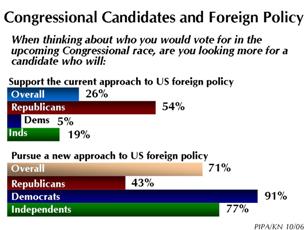Algebra I
 Looking at this graphic from a poll, I began to wonder what respective proportions Republicans, Democrats, and independents represented. Thinking back to Algebra I, I could see that there are three variables (the three proportions, let R = the proportion of Republicans, D= the proportion of Democrats, and I = the proportion of independents) and three equations. Based on the poll, the first two equations are:
Looking at this graphic from a poll, I began to wonder what respective proportions Republicans, Democrats, and independents represented. Thinking back to Algebra I, I could see that there are three variables (the three proportions, let R = the proportion of Republicans, D= the proportion of Democrats, and I = the proportion of independents) and three equations. Based on the poll, the first two equations are:54R + 5D + 19I = 26 [1]
43R + 91D + 77I = 71 [2]
The third equation is that the proportions must sum to 1.0, hence
R + D + I = 1 [3]
Rearranging equation [3], we get
D = 1 - R - I [3a]
Substituting [3a] into 1 gives us:
54R + 5 - 5R - 5I + 19I = 26, which reduces to
49R + 14I = 21 [1a]
Substituting [3a] into [2] gives us:
43R + 91 - 91R - 91I +77I = 71, which reduces to
48R + 14I = 20 [2a]
Subtracting [2a] from [1a] gives us;
R = 1 and by substitution into [1a]
I = -2 and by substition into [3]
D = 2
So, we conclude that Republicans are 100% of the sample, independents are a -200% of the sample, and Democrats are +200% of the sample.
Huh?
Sorry if that got too arcane, but what does it mean about the poll I wonder?


1 Comments:
Whoa, Nellie!
I agree that that graphic leaves a lot to be desired, but I think it means this:
1. A sample group was asked if they would vote for continuing or changing US foreign policy. Overall, 26% favored stay the course, and 71% favored change.
2. Further analysis of responses indicates that identified Republicans in the sample broke 54-43% for stay the course; but identified Democrats were 91-5% for change, and Independents, 77-19%.
3. The con:pro ratio is a bit below 3:1 for both the overall sample (76-21) and the %-age break out by affiliation. This suggests that the number of respondents who identified as R, D, or I are roughly about equal.
My algebra is a bit rusty, but I think the main flaw in the poll is that those equal proportions of R, D, & I in the sample don't reflect actual, voting populations.
My God, I fell into doing math/stats in public. HoundDog is going to have a field day.
Post a Comment
<< Home